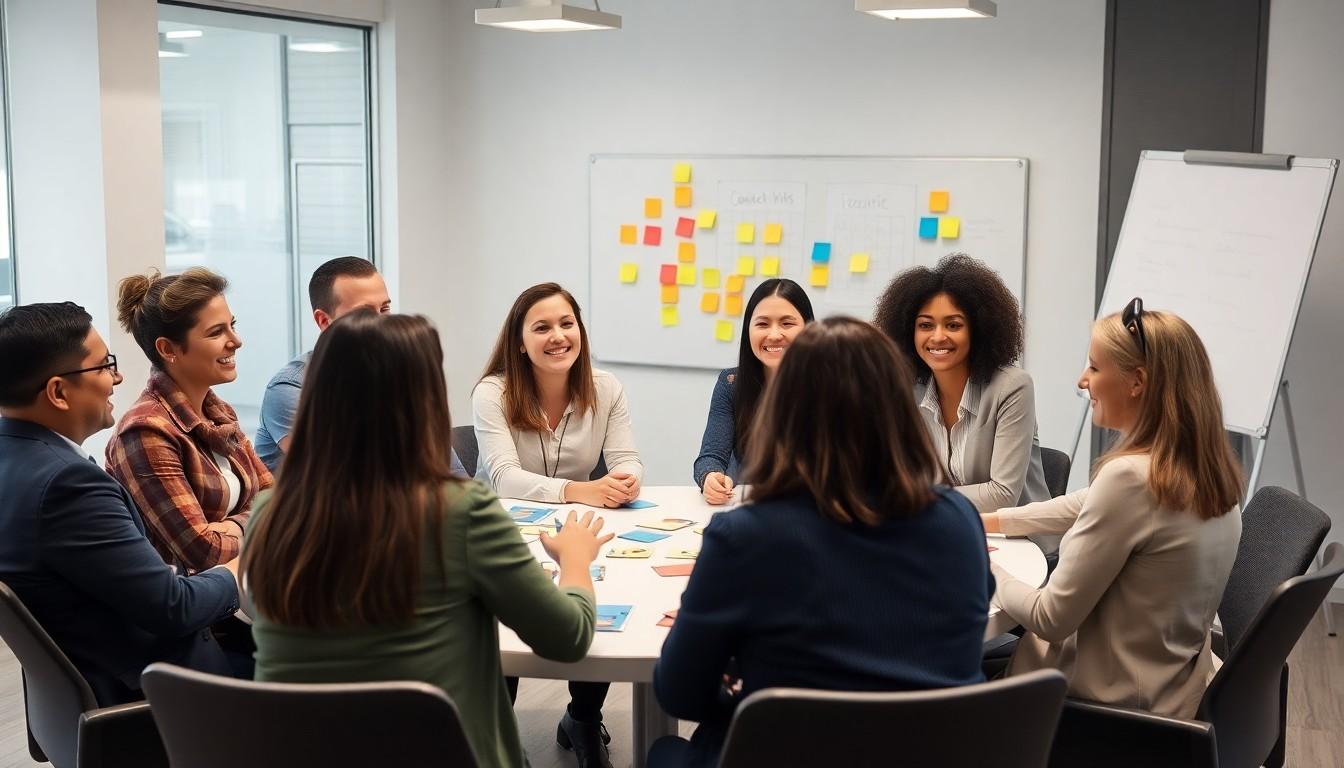The Best Fluffy Pancakes recipe you will fall in love with. Full of tips and tricks to help you make the best pancakes.

Conflict Resolution Activities That Transform Tensions Into Teamwork
Conflict is as inevitable as that one friend who always shows up late to dinner. Whether in the workplace, at home, or on the playground, disagreements can turn even the most peaceful environments into battlegrounds. But fear not! Conflict resolution activities are here to save the day, transforming tension into teamwork and misunderstandings into magic.
Conflict Resolution Activities
Conflict resolution activities encompass various strategies aimed at addressing and managing disagreements in diverse environments. These activities promote understanding and cooperation among individuals. Facilitating open communication stands as a core component; allowing participants to express their viewpoints fosters transparency.
Role-playing activities simulate real-life scenarios, enabling individuals to practice empathy and negotiation skills. By acting out different perspectives, participants gain insight into others’ feelings and motivations. Additionally, team-building exercises enhance trust and camaraderie among group members, creating a supportive atmosphere for conflict resolution.
Group discussions effectively harness collective problem-solving abilities. Engaging in structured dialogues encourages collaboration, leading to sustainable solutions. Activities such as brainstorming sessions allow participants to generate multiple ideas, providing the opportunity for creative resolutions.
Workshops on active listening sharpen individuals’ ability to comprehend diverse opinions. Training sessions focus on essential communication techniques and teach participants how to provide constructive feedback. These tools empower individuals to approach conflicts with confidence and clarity.
Furthermore, mediation activities use a neutral facilitator to guide conversations. A skilled mediator helps parties navigate their differences, ensuring each voice is heard. This approach often leads to mutually beneficial outcomes, strengthening relationships in the process.
Conflict resolution activities significantly reduce tension and build effective teamwork. By integrating these practices into various settings, such as workplaces, schools, or families, participants cultivate essential skills to handle disputes positively and constructively.
Importance of Conflict Resolution Activities

Conflict resolution activities play a crucial role in mitigating tensions across different settings. They enhance relationships and transform the way individuals interact with one another.
Benefits for Individuals
Individuals gain numerous advantages from participating in conflict resolution activities. Improved communication skills promote clarity and understanding in conversations. By engaging in role-playing, participants develop empathy, which helps them comprehend various perspectives. Heightened self-awareness allows individuals to recognize their emotional triggers and responses. Enhanced problem-solving abilities equip people to tackle disagreements more effectively. Lastly, increased confidence fosters assertiveness, empowering individuals to convey their ideas and concerns clearly and respectfully.
Benefits for Organizations
Organizations benefit immensely from implementing conflict resolution activities. Stronger teamwork emerges as employees learn to collaborate and support one another in challenging situations. Enhanced morale helps maintain a positive workplace, which ultimately boosts productivity. Effective conflict management reduces the likelihood of escalated disputes, minimizing disruptions. Additionally, improved relationships among staff contribute to better communication across departments. Organizations that prioritize these activities often see a decrease in employee turnover, as a harmonious work environment encourages retention and commitment.
Types of Conflict Resolution Activities
Various types of conflict resolution activities exist, each tailored for specific situations. These activities help address disagreements effectively.
Collaborative Activities
Collaborative activities encourage teamwork and mutual understanding. Team-building exercises facilitate connection among participants, allowing them to share perspectives openly. Group problem-solving tasks enable individuals to brainstorm solutions collectively, fostering a sense of camaraderie. Workshops focused on communication skills enhance participants’ ability to listen and respond constructively. These exercises often include stories or role-playing that reflects real-life situations, promoting empathy. Trust-building activities create a safe environment for sharing thoughts and feelings, further strengthening relationships. Overall, collaborative activities emphasize cooperation, leading to more effective conflict resolution.
Competitive Activities
Competitive activities present an engaging way to address conflicts. These activities often involve friendly challenges that require individuals to work together while ultimately striving to win. Games or simulations stimulate problem-solving skills and strategic thinking, pushing participants to collaborate despite differing views. Scenarios allow individuals to confront issues head-on, providing an opportunity for constructive dialogue in a controlled setting. Points or rewards often accompany these activities, motivating further participation. Competitive environments can also highlight strengths and weaknesses, helping individuals recognize areas for improvement.
Effective Implementation of Conflict Resolution Activities
Effective implementation of conflict resolution activities requires thoughtful strategies and engagement. Focused preparation and structured facilitation enhance the outcomes of these activities.
Preparing Participants
Preparation entails creating a conducive environment for open dialogue. Setting clear expectations helps participants understand the goals of each activity. Informing them about the processes promotes comfort and willingness to engage. Including ground rules encourages respectful communication and active listening. Engaging icebreakers can ease initial tension, fostering a supportive atmosphere. Ensuring everyone feels valued aids in building trust and motivates participation. Prior preparation leads to more meaningful interactions, enhancing the overall effectiveness of the resolution activities.
Facilitating Discussions
Facilitating discussions revolves around guiding dialogue and managing dynamics carefully. Using open-ended questions prompts deeper reflection and encourages diverse perspectives. Active listening demonstrates respect for each participant’s input and fosters a collaborative spirit. Summarizing key points helps clarify misunderstandings and reinforces shared insights. Balancing contributions from all participants prevents domination by a few voices, ensuring equitable engagement. Introducing breakout groups facilitates more intimate discussions, increasing comfort levels. Effective facilitation transforms conversations, empowering participants to navigate conflicts constructively.
Measuring the Success of Conflict Resolution Activities
Effectiveness of conflict resolution activities can be assessed through several indicators. First, participant feedback provides valuable insights into subjective experiences during activities. Surveys and interviews gauge satisfaction levels and perceptions of personal growth, allowing organizations to tailor future sessions.
Second, observable changes in behavior highlight successful outcomes. Enhanced communication skills often manifest in decreased misunderstandings and improved teamwork. Employees engaging in constructive dialogue illustrate the impact of conflict resolution practices.
Third, tracking conflict frequency serves as a quantifiable measure. Documentation of disputes pre- and post-activities reveals shifts in conflict dynamics. A noticeable decline indicates effective resolution strategies.
Fourth, assessing team morale can show the success of these activities. High morale often correlates with improved relationships. Employee engagement surveys or informal discussions can reveal positive shifts in workplace culture.
Fifth, analyzing productivity metrics offers another perspective. Enhanced collaboration typically leads to increased efficiency and output. Organizations focused on resolving conflicts report higher performance levels and reduced employee turnover.
Lastly, monitoring participation in follow-up activities signifies sustained engagement. Return rates for subsequent training sessions suggest that participants value the conflict resolution initiatives. This ongoing commitment reinforces the importance of these activities in building a cohesive environment.
Overall, measuring success through diverse approaches, including feedback, behavior changes, conflicts frequency, team morale, productivity metrics, and engagement levels, provides a comprehensive understanding of the impact of conflict resolution activities.
Conflict resolution activities play a vital role in transforming disagreements into opportunities for growth. By fostering open communication and understanding, these activities empower individuals to navigate conflicts with confidence.
Whether through collaborative team-building exercises or competitive problem-solving tasks, participants gain valuable skills that enhance their relationships and teamwork. Organizations that prioritize these initiatives witness improved morale and productivity, creating a more harmonious work environment.
Ultimately, embracing conflict resolution activities not only mitigates tensions but also cultivates a culture of cooperation and respect, paving the way for lasting positive change in various settings.
